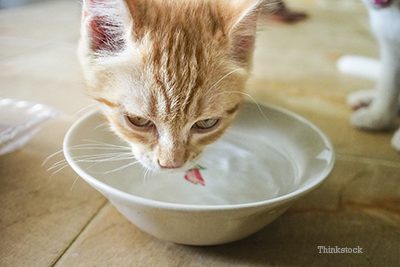Contents
My cat drinks a lot: should I be concerned?
Even if it’s no longer hot, do you still observe your cat emptying his water bowl? Is your cat drinking more water than its usual intake? If so, you must be wondering why is your cat drinking so much? The reasons can be many: behavior problems, polyuria, diabetes or any other metabolic disorder.
Let’s explore this symptom in more depth to understand why a cat’s water needs can suddenly increase.
How much does a cat drink too much?
Typically, cats don’t drink a lot of water because they have high performing kidneys that recycle a lot. Despite this, there are some issues that can cause a cat to drink more water. So how much water should a cat drink?
The normal water consumption for a cat should be on average 60 ml / kg per day for the optimal functioning of its organs. If he weighs 5 kg, that is 300 ml, you see it is not a lot.
However, under normal circumstances, a cat’s water intake depends a lot on their diet. A cat on mash drinks less water than a cat on a kibble diet because wet or canned food contains 80% water, compared to only 10% in dry food.
If your cat empties his water bowl too often, calculate how much he’s drinking. If it exceeds 100 ml / kg in 24 hours, it is called polydipsia, and it is a reason for a visit to his veterinarian. Different situations can cause you to need more fluids than your body would normally need:
- The cat’s water intake may increase depending on environmental conditions or diet;
- Sometimes your cat drinks more water just to get more attention from its human parents, this is a behavioral problem; it also happens that some cats start to drink more water due to a change in the routine or the location of their bowl;
- Finally unfortunately, excessive water consumption can indicate an underlying metabolic disorder. Hyperthyroidism, diabetes, and kidney disease are the main problems associated with increased water intake in cats.
If your cat shows signs of polydipsia, never stop him from drinking, but see a vet immediately.
What are the signs that my cat is drinking too much water?
It can be difficult at first to spot an increase in water intake, especially if the cat has access to the outdoors, you have multiple pets, or a water dispenser with a large tank. It is up to you to try to detect changes in his consumption behavior:
- Go to his water bowl more often;
- Has changes in appetite;
- Go to his litter box more often;
- Sleeps more than usual;
- Shows signs of general behavior change;
- Suffers from weakness, vomiting and / or diarrhea.
Probable medical causes: why is my cat drinking more water?
Excessive thirst can be due to an underlying health problem involving the kidneys and urinary tract. If your cat is showing signs of excessive thirst along with weight loss and increased urination, it could be suffering from kidney disease or diabetes mellitus. This requires a consultation with the veterinarian without further delay.
A physical exam, blood test, and / or urinalysis is often done to understand the increase in water consumption in cats. A general blood profile is recommended to determine changes in glucose levels, kidney and liver enzymes. Other tests may be done to assess thyroid hormone levels and red and white blood cell counts. A urine sample from a cat will give detailed information about the presence of blood, protein, and glucose concentration in the urine.
Chronic kidney disease / renal failure
The kidneys are responsible for removing waste products from the blood, maintaining electrolyte balance, maintaining water balance and producing certain hormones. Any problem with the kidneys leads to dilution of the urine. As a result, cats begin to urinate often and the kidneys are unable to completely remove waste. To compensate for water loss, cats drink more water to maintain hydration.
Other symptoms of kidney disease are loss of appetite, nausea, weight loss, vomiting, or diarrhea. Kidney failure is most often caused by the aging of the organ over the years, but can also be caused by blocked arteries, a blocked urinary tract, an infection or a blood clot.
Glomerulonephritis is another kidney disease that can lead to kidney failure in cats. In this disease, the kidneys cannot properly filter the blood, which leads to the leakage of many essential proteins. It is a disease that can be fatal.
Diabetes mellitus
This disease is characterized by high levels of sugar in the blood. The kidneys are unable to retain all this glucose, which therefore passes through the urine by carrying water by osmosis. The cat feels dehydrated and needs to drink more water. This disease occurs when the body cannot use or produce the hormone insulin, which is responsible for regulating blood sugar levels. The risk factors for diabetes in cats include obesity, genetics and lack of physical activity, among others.
Hyperthyroidism
When the cat’s thyroid gland becomes overactive and produces excess thyroid hormones, hyperthyroidism develops.
Thyroid hormones are important for basic metabolic functions, such as nutrient uptake and heat regulation. When the gland becomes overactive resulting in excess production of thyroid hormones, it increases metabolism, appetite, and thirst, which can lead to restlessness, increased urination, and weight loss. In such a situation, the heart rate and blood pressure may increase, which makes the heart work faster.
Conclusion
Try to regularly monitor the daily amount of water your feline is drinking. If your cat suddenly begins to obsess over water and urinates too often, never restrict their access to water, but take them to the vet to find out why your cat is so thirsty.










